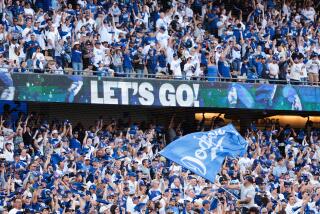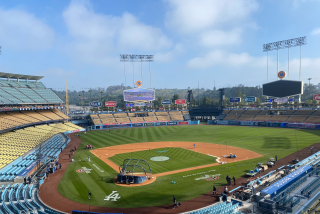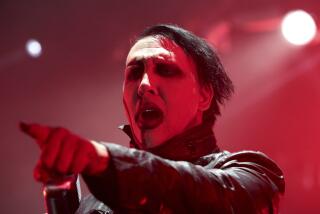Los Angeles
Madonna has never been a paragon of restraint--there’s a news flash--but even some of her longtime fans were taken aback when they saw the steep prices for her Drowned World tour, which arrives at Staples Center on Sunday.
After it was announced that the best seats would go for a jolting $500 per pair, Web sites devoted to the singer lighted up with debate over whether Madonna was (a) becoming greedy and insensitive to her fans, or (b) just a material girl living in a material world.
The answer depends on your point of view, but it should be noted that the entire 12-city U.S. Drowned World tour sold out in minutes, including the four-night stand in Los Angeles that concludes the tour.
The sales rush proves that the 43-year-old singer, touring for the first time in eight years, is still very much in vogue. Eighteen years ago this month she released her first hit single, “Lucky Star,” and the title is still a fitting theme and starting point for her amazing career. The sellouts also make you wonder about those ticket prices.
“Considering that sellout, I suppose you could make a case that she could have actually charged more,” said Gary Bongiovanni, editor of Pollstar, the concert industry trade. “And in a market like L.A. she could have charged a lot more.”
How much more? Concert industry insiders say the very best Drowned World tickets could have been priced at $1,000 a pair or even higher and still been bought.
That view is backed by classified ads in this paper and others: Ticket agents and amateur scalpers have advertised prime seats for $1,250 per pair and, in one case, an eye-popping $5,990 for two tickets in fifth row center.
“They’re still available, but we do expect to sell them,” said a phone sales operator for Tickets Entertainment, the ticket service based in Kirkland, Wash., that is offering Madonna tickets for the price of a used Honda. “Other agents are selling a pair like that for $6,000 or $7,000.”
That may be the hyperbole of hard sell, but, clearly, there is some big money being tossed around to see Madonna. And her fans say it’s completely appropriate considering what the singer is offering on this tour. This is not a show that will be confused with a taping of MTV’s “Unplugged.”
The 100-minute feast of eye candy features squads of dancers and a barrage of special effects, not to mention a mechanical bull, aerial martial arts, contortionists and what must certainly be the world’s largest kimono. Divided into four subsections (each with a costume change, of course), the show melds imagery from Japanese anime , flamenco dance floors and a Wild West that, if it existed, would have had more nightclubs than corrals.
“I saw the show opening night, and it’s an unbelievably ambitious production,” said manager Jim Guerinot, who works with Beck, the Offspring and No Doubt. “If Madonna was going out as a solo acoustic act, people would scratch their heads a little bit more. But when you get into elaborate productions like the ones she or U2 are doing, it’s very, very expensive to take it on the road.”
And very, very lucrative. Ambitious trappings are hardly new for the pop and rock concert world (anyone remember Pink Floyd’s flying pig?), but in recent years there has been a new mind-set when it comes to charging major money for big-name live entertainment--whether it comes with special effects or not.
Barbra Streisand famously raked in millions for her Las Vegas shows around New Year’s Eve 1999 that cost $5,000 for two seats, and not just for the good ones. Here in Southern California, the fans who wanted to ring in 2000 with either the Eagles or Jimmy Buffett had to plunk down $2,000 for the best seats. Buffett at least offered an open bar.
Those shows, though, weren’t tours; they had the once-in-a-lifetime confetti of the millennium falling on them. Same goes with the all-star Michael Jackson tribute this week in New York, where $5,000, and some luck, will get you two ringside seats to an event with more star power than most Grammy galas. Still, the prices rub people wrong--including Jermaine and Randy Jackson, who said they considered skipping the tribute show because of queasy feelings about appearing mercenary.
That doesn’t seem to concern Madonna. With the quick sellout, it’s safe to say Madonna, the promoter and others mounting the tour must be thrilled, right? Not quite.
A top official with the tour’s promoter, Clear Channel, recently told one of the Hollywood trades that “on that tour we probably didn’t charge near enough.” He then compared a seat at a Madonna show to a courtside seat for the New York Knicks--and those run $3,200 per pair for a regular season game. So maybe Madonna fans got off lucky, after all.
Soaring ticket prices are nothing new for pop music events, especially those shows that can pack in middle-aged fans who sit on wallets full of credit cards. The intriguing element of the equation now, though, is that even as ticket prices continue to take off, the concert business as a whole is sputtering.
“The business is flat,” said CAA music agent Rick Roskin, who has represented Eric Clapton, Santana and the Smashing Pumpkins. “It’s a combination of the economy having definitely slowed down, who’s on the road right now and also the ticket-pricing issue.”
The calculus of ticket prices is an interesting back-room process that typically begins with artists picking the payoff they want for an entire tour and sizing up the production costs. The promoters then figure out the number of shows, the venue sizes and, finally, the cost of each seat to generate the cash that--they hope--will make money for everyone involved.
The entire process changed dramatically in 1994, when tiered pricing models became the rage among veteran acts that realized their graying fans were now well-heeled, willing to pay for plum vantage points and accustomed to dealing with scalpers. That year, the Eagles, the Rolling Stones and Pink Floyd all embraced the tiered system, moving away from the one-price models.
Also in 1994, the Eagles broke the triple-digit price barrier with their Hell Freezes Over tour and set up the “golden circle” seating model that goosed up the price for the best seats.
In effect, artists, no longer troubled by the anti-establishment mind-set of 1960s rock, decided that they might as well become their own scalpers.
“The promoters and artists pointed to the scalpers and said, ‘Look, we’re not raising the prices that much, because look what the fans are already paying. It’s just that now the money is coming to us and not the scalper,”’ Bongiovanni said. “And there’s some truth there. If the fans were willing to pay triple-digit prices for the good seats, that meant the product was probably undervalued.”
The prices have been kept down, in part, by the very nature of that product--and the fact that no one in the earlier days of rock music would have ever called concert performances a “product.”
“For many years, there was a certain rebelliousness and counterculture credential you had with your audience as a rock star, and if you were charging really high ticket prices you risked a fan view that you were part of the establishment,” he said. “Now they looked around and saw a lot of the fans from the ‘60s and ‘70s had good jobs, were driving BMWs and had changed their politics.”
*
By 1998, the tiered system and the acceptance of high-priced tickets had trickled down throughout the industry and become the norm. Certainly, though, some artists still feel pressure, either from public perception or their own comfort level, and don’t seek the highest price they could probably charge.
U2’s top ticket of $130 could certainly have been higher, and Bruce Springsteen and the E Street Band’s reunion shows last year could have brought in a marquee price higher than $67.50. The artists have to weigh how their prices fit in with their art and persona, possibly tapping the spiritual side of rock or a blue-collar image.
“That boils down to an artist choice and what their relationship with their fans is, what their comfort zone is. You have polar opposites of Fugazi on one end and Madonna on the other. You have to see where everybody is on that range,” Guerinot said, referring to the cult favorite hard-core rock band that eschews all the trappings and corporate sensibilities that have become the norm in mainstream popular music.
One of the most successful tours of this year teamed longtime piano men Billy Joel and Elton John, a dream bill for baby boomers who bought all those albums from the two veteran artists in the singers’ 1970s and 1980s heydays. The average price for that tour showed the artists knew most of their fans have 401(k)s. The average price for seats was $202 for a pair; the best seats went for $350 per pair.
“For the ticket prices of this show,” Joel joked from the Forum stage, “we should be in your living room.”
*
Not all concerts have followed the high-pricing parade. Pearl Jam entered a protracted and unresolved battle with Ticketmaster to protest rising ticket service charges and clearly lost career momentum by resisting the system. Garth Brooks has long kept his ticket prices down, often at less than $40 for a pair, in a nod to the blue-collar roots of his audience and the populist vibe of his shows.
Traditionally, acts that appeal primarily to youth audiences tamp down their individual ticket prices to cater to their audiences. The average ticket price for the recently completed ‘N Sync tour, though, was $108 for a pair--up from the average of $92 a pair from last year. The show had an incredibly elaborate production, however, and in some of the larger venues the nosebleed seats were $20 a pair, giving parents a cheaper out if their daughters absolutely, positively had to see the band in person.
After the tier system, the other big change in the concert world has been within the boardrooms of the industry itself, as consolidation has altered the landscape.
SFX Entertainment was the dominant force in the industry last year when it was bought up by Clear Channel Communications, the dominant player in U.S. commercial radio broadcasting. The Clear Channel behemoth now scoops up entire tours before they start, setting concert prices for the national runs. The promoter’s $830 million in annual concert proceeds is more than those of its next 10 competitors combined.
The effect? Ask Guerinot why average ticket prices of top tours have almost doubled, and he doesn’t hesitate when asked for an explanation: “Industry consolidation. No question.” Lack of competition and the huge paydays Clear Channel is offering to hold onto its exclusivity power have sent ticket prices soaring, managers and agents say.
That doesn’t mean fans are always buying. Certainly Madonna, U2 and ‘N Sync are hot tours this year, but the overall concert market of the moment is a bit shaky. Ticket sales have sagged 15% since last year among the 50 top-grossing concert tours.
The malaise has affected even some of the hottest acts of the day. Destiny’s Child and Janet Jackson, who sell truckloads of albums, have played to some venues with larger-than-expected blocks of empty seats in recent months. Veteran Rod Stewart and newcomer Dido have looked out on audiences on some nights when one-third of the chairs were staring back at them.
Concert industry insiders cite, first and foremost, the flattening economy and the way it makes customers blanch at steep ticket prices. And those prices are quite steep.
Through the first six months of this year, the average ticket price among the 50 top-grossing tours rang up to $46.69--which is 43% higher than it was just three years ago. Then there are the service charges, cost of parking, food, drinks and so on.
“Obviously, there is a point where you turn people off,” Guerinot said. “The fan that says, ‘Oh, I’d like to check out that show,’ and then sees the price and decides to pass.”
Leaders in the concert promotion industry point out that escalating prices for the performing arts, Broadway-style fare and professional sporting events make pop world concerts a comparative bargain. They also say the tiered pricing system has a low-end side. At the Madonna shows, for instance, you may end up sitting in the echo-filled heights of Staples Center, but if you really want to see the show without taking out a loan, you can get the $45 seats--but you have to find some first, and you might want to bring a pair of small binoculars to check out Madonna’s cowboy costume.
*
Still, those high-priced tickets are the ones that catch everybody’s eye and are the story of the moment in the concert industry. The question is if they might be priced too high for their own good.
“If the prices keep going up and the market keeps coming down, you would suspect the numbers have to meet in the middle sometime,” Bongiovanni said. “Madonna will be doing just fine anyway, but other artists will lose out and fans might decide to go see a movie.”
*
Madonna plays Sunday, Tuesday, next Thursday and Sept. 14 at Staples Center, 1111 S. Figueroa St., downtown L.A., 8 p.m. (213) 742-7340. Sold out.
(BEGIN TEXT OF INFOBOX / INFOGRAPHIC)
‘N Sync PopOdyssey 2001 Tour
Average ticket price: $54
Top ticket price: $66
*
Billy Joel & Elton John Face to Face Tour
Average ticket price: $101
Top ticket price: $175
*
Janet Jackson All for You Tour
Average ticket price: $62
Top ticket price: $80
Madonna Drowned World Tour
Average ticket price: $114
Top ticket price: $250
More to Read
The biggest entertainment stories
Get our big stories about Hollywood, film, television, music, arts, culture and more right in your inbox as soon as they publish.
You may occasionally receive promotional content from the Los Angeles Times.










